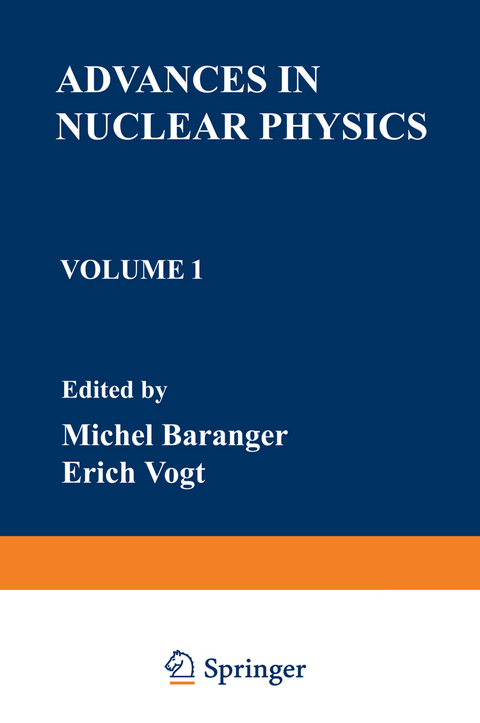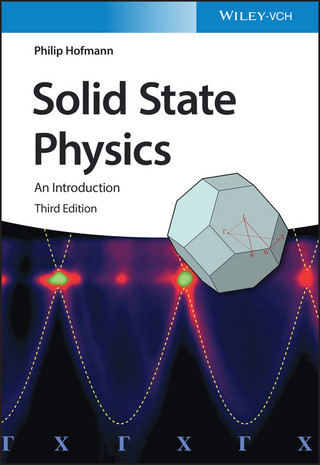
Advances in Nuclear Physics
Springer-Verlag New York Inc.
978-1-4757-0105-0 (ISBN)
1 The Reorientation Effect.- 1. Introduction.- 2. Classical Estimates of Effects.- 3. Theory of Coulomb Excitation.- 4. Theory of the Reorientation Effect.- 5. Excitation via the Giant Dipole Resonance.- 6. Experimental Methods.- 7. Reorientation Experiments.- Acknowledgments.- Appendix I. Numerical Expressions.- Appendix II. Tables of Orbital Integrals.- Appendix III. Approximate Formula for the Reorientation Effect.- References.- 2 The Nuclear SU3 Model.- 1. Introduction.- 2. Basic Shell Model.- 3. Symmetry of Oscillator Quanta — The Groups U3 and SU3.- 4. The Effective Interaction.- 5. Application of the SU3-Coupling Scheme to Light Nuclei.- 6. Summary and Developments.- Acknowledgments.- References.- Appendix A. Harmonic Oscillator.- Appendix B. Use of Groups in Quantum Mechanics.- Appendix C. The Symmetric and Unitary Groups.- Appendix D. Generating Operators of Us.- Appendix E. Classification According to SU3 without the Harmonic Oscillator.- Appendix F. Raising and Lowering Operators of the Group SU3.- Appendix G. Calculation of Matrix Elements.- Appendix H. The Normalization Coefficients and Overlaps.- Appendix I. Use of the Group SU3 in the Classification of Elementary Particles.- 3 The Hartree-Fock Theory of Deformed Light Nuclei.- 1. Introduction.- 2. The Hartree-Fock Equations.- 3. Symmetries of the Hartree-Fock Hamiltonian.- 4. The Choice of an Expansion for the Orbits.- 5. Single Major Shell Hartree-Fock Calculations.- 6. Solutions of the Single Major-Shell Hartree-Fock Calculations for Even-Even N = Z Nuclei.- 7. Deformed Excited Equilibrium States of Spherical Nuclei.- 8. A Soluble Model—The Effect of the Exchange Components of the Interaction.- 9. The Deformation of the Hartree-Fock Field—The Quadrupole-Quadrupole Interaction.- 10. The Effect ofthe Spin-Orbit Splitting.- 11. The Multiplicity of Hartree-Fock Solutions.- 12. Hartree-Fock Solutions of Other Nuclei.- 13. Magnetic Moments of Odd-A Nuclei.- 14. Angular Momentum Projection.- 15. Major-Shell-Mixing Hartree-Fock Calculations—Quadrupole Polarization of Closed Shells.- 16. Conclusion.- Acknowledgments.- References.- 4 The Statistical Theory of Nuclear Reactions.- 1. Introduction.- 2. The Model for Average Cross Sections.- 3. Application of the Evaporation Model.- 4. Basis of the Evaporation Model in Reaction Theory.- 5. Conclusions.- Acknowledgments.- Appendix A. Absorption Cross Section of a Complex Square Well.- Appendix B. Effect of Finite Averaging Interval.- References.- 5 Three-Particle Scattering—A Review of Recent Work on the Nonrelativistic Theory.- 1. Introduction.- 2. The Amado Model.- 3. The Faddeév Equations.- 4. Application of the Faddeév Equations.- 5. Concluding Remarks.- Acknowledgments.- References.- Appendix A.- Appendix B.- Appendix C.- Appendix D.- Appendix E.
| Reihe/Serie | Advances in Nuclear Physics ; 1 |
|---|---|
| Zusatzinfo | 13 Illustrations, black and white; XIV, 418 p. 13 illus. |
| Verlagsort | New York, NY |
| Sprache | englisch |
| Maße | 152 x 229 mm |
| Themenwelt | Naturwissenschaften ► Physik / Astronomie ► Atom- / Kern- / Molekularphysik |
| ISBN-10 | 1-4757-0105-5 / 1475701055 |
| ISBN-13 | 978-1-4757-0105-0 / 9781475701050 |
| Zustand | Neuware |
| Haben Sie eine Frage zum Produkt? |
aus dem Bereich


